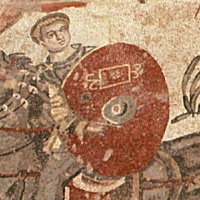
This page created 26 August 2014, and last modified: 8 December 2015 (references rearranged)

The Equites Dalmatae passerentiaci is listed (102/5.16 in Ingo Maier's numbering scheme) as the fourth of the vexillationes comitatenses in the Magister Equitum's cavalry roster; it is assigned to his Gallic command as the (102/5.226) Equites Dalmatae passerentiacenses. Its shield pattern (100#14) as shown in various manuscripts, under the label (100.o) Passerentiaci, is as below:

The shield pattern has a red rim, a white boss (yellow in M), and a green main field. Except in B, the field is decorated by two small rectangles, somewhat taller than wide, in approximately the 2 or 3 and 10 or 9 o'clock positions of the shield; they are blue with green centres (O, P), yellow (M, and more square than oblong), or white (W). These boxes might well represent a pair of rectangular Imperial portraits, albeit at a scale too small to have been successfully drawn. The only other cavalry unit depicted with such a rectangular box is the Equites octavo Dalmatae (102/5.15), also in the Magister Equitum's Gallic command, which has its single example in the 12 o'clock position that was more typical for such portraits (e.g. see the Sagittarii iuniores Gallicani, 9.30); this was a particularly common position for shield decorations generally to appear during the Tetrarchy, 100 years before the Notitia was compiled; an example of a cavlaryman's shield showing such a motif can be seen in the Piazza Armerina mosaics in Sicily, as shown below:

The name Dalmatae comes from Dalmatia, from where a dozen or so auxiliary infantry cohorts were recruited in the first century; a few of these kept their names intact long enough to make it into the Notitia, such as the men under the Tribunus cohortis secundae Dalmatarum (154.27), responsible to the Dux Britanniarum. However, the great majority of Dalmatae units in the Notitia are, like the Equites Dalmatae passerentiaci, cavalry units. They seem to have been a major component of the much-expanded cavalry forces raised in the 3rd quarter of the 3rd century; exactly how "Dalmatian" cavalrymen were distinguished from those of other units is not yet understood.
The epithet Passerentiaci might refer to "sparrows" or similar (passer being the Latin for small passarine birds such as sparrows), but perhaps more likely refers to an as yet unidentified place, such as the former town of Passaron in Molossian Epirus that was razed by the Romans, for example.
1. Ingo Maier; "Appendix 4: Numeration of the new edition of the compilation 'notitia dignitatum' (Cnd)"; last accessed 26 October 2015. See also for here for numbering examples. Return

Return to the Notitia alphabetical unit list page.
Return to my Notitia index page.